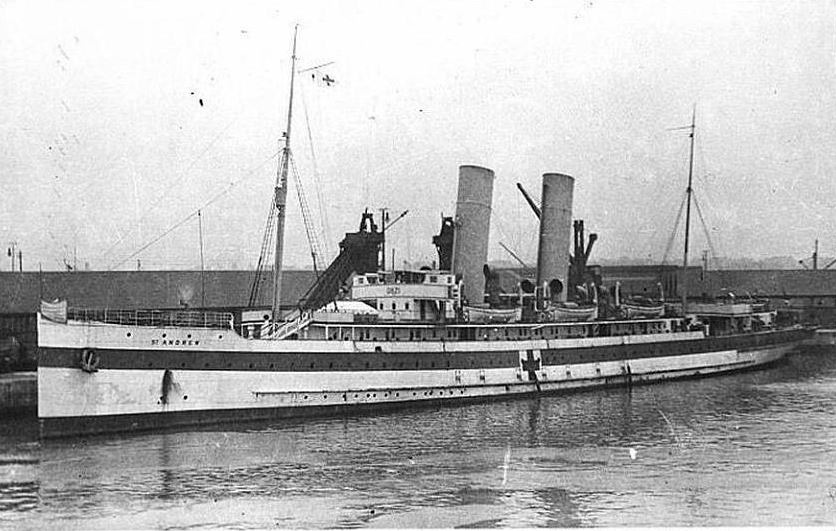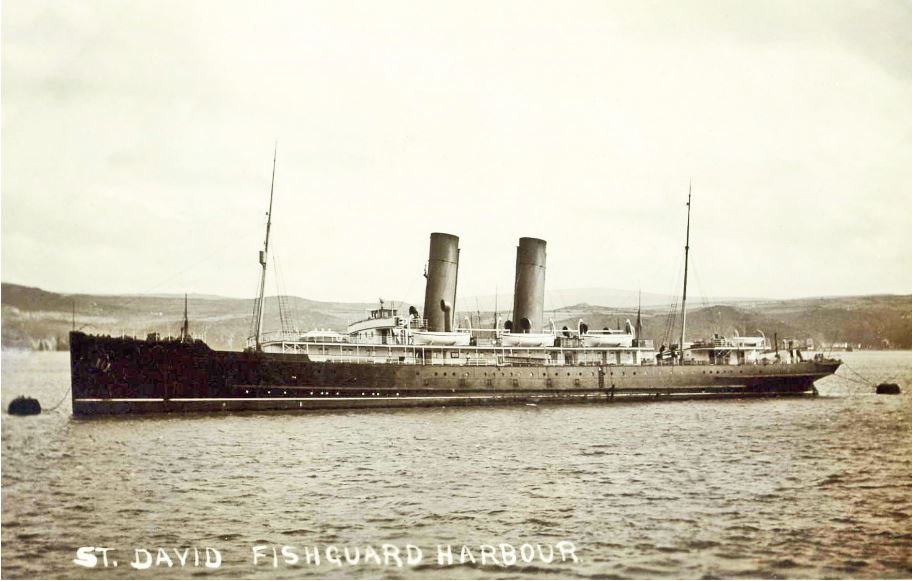Difference between revisions of "HMHS St Andrew"
From Our Contribution
(→France to England 7 November 1917) |
(→Remarks) |
||
| (18 intermediate revisions by the same user not shown) | |||
| Line 1: | Line 1: | ||
| − | {{Infobox | + | {{Infobox ship |
| − | | | + | | image = [[File:HMHS_St_Andrew.jpg]] |
| − | + | | caption = courtesy canadianmountedrifles.yolasite.com | |
| − | + | | image2 = [[File:HMHS_St_Andrew_1.jpg]] | |
| − | + | | caption2 = Pre war St Andrew in Fishguard harbour | |
| − | + | | shipname = HMHS St Andrew | |
| − | + | | shipowner = Fishguard & Rosslare Railway & Harbour Co, London | |
| − | | caption = | + | | shipbuilder = John Brown & Co Ltd, Scotland |
| − | | | + | | shipyardnumber = 382 |
| − | | caption2 = | + | | shiplaunched = 19 Dec 1907 |
| − | + | | shipcompleted = April 1908 | |
| − | + | | shipinservice = 1908 | |
| − | + | | shipoutofservice = 1933 | |
| − | + | | shipinservice2 = | |
| − | + | | shipoutofservice2 = | |
| − | | | + | | shipreclassified = |
| − | + | | shipID = | |
| − | | | + | | shipfate = scrapped |
| − | | | + | | shiptype = Cross Channel Ferry |
| − | + | | shiptonnage = 2,495 tons | |
| − | | | + | | shiplength = 351.1 ft (107.02m) |
| − | | | + | | shipbeam = 41.1 ft (12.53m) |
| − | + | | shipdepth = 24.8 ft (7.56m) | |
| − | | | + | | shippropulsion = three screws |
| − | | | + | | shipspeed = 21 knots (38.89 km/h) |
| − | + | | shipcapacity = 574 x 1st class, 426 x 2nd class | |
| − | | | + | }} |
| − | |||
| − | |||
| − | | | ||
| − | | | ||
| − | |||
| − | |||
| − | |||
==Remarks== | ==Remarks== | ||
| − | Owned by Great Western Railways | + | Owned by Great Western Railways and utilised as a cross channel ferry between Fishguard in Wales and Rosslare in Ireland. In 1914 it was one of the first ships taken over by the Ministry of Defence, and fitted out as a Military Hospital Ship. From 19 Aug 1914 until 25 May 1919 ''St Andrew'' was operating as a hospital ship. Her first trip was to Le Havre on 24 Aug 1914. Her first run back with patients, from Rouen (up the River Seine from Le Havre), carrying 63 lying and 147 sitting patients. Staff comprised 4 Medical Officers, 4 Nurses and 26 other staff. She was capable of accommodating 16 Officers, 23 Cots and 155 Berths. |
| − | |||
| − | |||
| − | |||
| − | After the war it returned to its normal role, and was renamed ''Fishguard'' in 1932, | + | After the war it returned to its normal role, and was renamed ''Fishguard'' in 1932, before a year later, being sold for scrap. |
==Soldiers carried== | ==Soldiers carried== | ||
| − | ==France to England 18 August 1916== | + | ===Rouen France to England 29 July 1916=== |
| − | *[[John Whittaker]] | + | * [[James Thomson MM]] |
| − | ==France to England 4 September 1916== | + | ===France to England 18 August 1916=== |
| − | *[[Jack Hayden Gibson]] | + | * † [[John Whittaker]] |
| − | *[[Leslie Jeffery Harvey]] | + | ===France to England 4 September 1916=== |
| − | ==France to England October 1916== | + | * [[Jack Hayden Gibson]] |
| − | *[[Frederick James Bishop]] | + | * [[Leslie Jeffery Harvey]] |
| − | ==France to England 15 December 1916== | + | ===France to England October 1916=== |
| − | *[[Lyndon Vivian Brady]] | + | * [[Frederick James Bishop]] |
| − | ==Boulogne to England 2 March 1917== | + | ===France to England 15 December 1916=== |
| − | *[[George Scrivener]] | + | * [[Lyndon Vivian Brady]] |
| − | + | ===Rouen to England 5 Jan 1917=== | |
| − | ==France to England May 1917== | + | * [[John (Senior) Shepherd]] |
| − | *[[Edward Dudley Mann]] | + | ===Boulogne to England 2 March 1917=== |
| − | ==France to England 8 October 1917== | + | * † [[George Scrivener]] |
| − | *[[Frederick Robert Weedon]] | + | ===Boulogne to England 24 April 1917=== |
| − | ==France to England 11 October 1917== | + | * [[Albert Helliwell]] |
| − | *[[Robert Frank Bickford]] | + | ===France to England 14 May 1917=== |
| − | ==France to England 7 November 1917== | + | * [[Edward Dudley Mann]] |
| − | *[[Frank Moore]] | + | ===France to England 8 October 1917=== |
| − | + | * [[Frederick Robert Weedon]] | |
| − | ==France to England 15 January 1918== | + | ===France to England 11 October 1917=== |
| − | *[[Hubert Maitland Armstrong MM]] | + | * [[Robert Frank Bickford]] |
| − | ==France to England June 1918== | + | ===France to England 7 November 1917=== |
| − | *[[Gordon Edgar (George) Bennett]] | + | * [[Frank Moore]] |
| − | ==France to England 14 July 1918== | + | ===France to England 15 January 1918=== |
| − | *[[Alfred Tennyson Needham]] | + | * [[Hubert Maitland Armstrong MM]] |
| − | ==France to England 3 March 1919== | + | ===France to England June 1918=== |
| − | *[[Richard Edgar Riley]] | + | * [[Gordon Edgar (George) Bennett]] |
| + | ===France to England 14 July 1918=== | ||
| + | * [[Alfred Tennyson Needham]] | ||
| + | ===France to England 3 March 1919=== | ||
| + | * [[Richard Edgar Riley]] | ||
[[Category:Ships]] | [[Category:Ships]] | ||
Latest revision as of 19:04, 15 January 2023
Contents
- 1 Remarks
- 2 Soldiers carried
- 2.1 Rouen France to England 29 July 1916
- 2.2 France to England 18 August 1916
- 2.3 France to England 4 September 1916
- 2.4 France to England October 1916
- 2.5 France to England 15 December 1916
- 2.6 Rouen to England 5 Jan 1917
- 2.7 Boulogne to England 2 March 1917
- 2.8 Boulogne to England 24 April 1917
- 2.9 France to England 14 May 1917
- 2.10 France to England 8 October 1917
- 2.11 France to England 11 October 1917
- 2.12 France to England 7 November 1917
- 2.13 France to England 15 January 1918
- 2.14 France to England June 1918
- 2.15 France to England 14 July 1918
- 2.16 France to England 3 March 1919
Remarks
Owned by Great Western Railways and utilised as a cross channel ferry between Fishguard in Wales and Rosslare in Ireland. In 1914 it was one of the first ships taken over by the Ministry of Defence, and fitted out as a Military Hospital Ship. From 19 Aug 1914 until 25 May 1919 St Andrew was operating as a hospital ship. Her first trip was to Le Havre on 24 Aug 1914. Her first run back with patients, from Rouen (up the River Seine from Le Havre), carrying 63 lying and 147 sitting patients. Staff comprised 4 Medical Officers, 4 Nurses and 26 other staff. She was capable of accommodating 16 Officers, 23 Cots and 155 Berths.
After the war it returned to its normal role, and was renamed Fishguard in 1932, before a year later, being sold for scrap.

